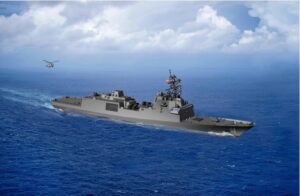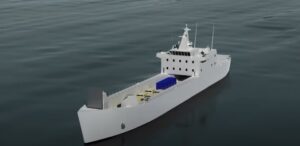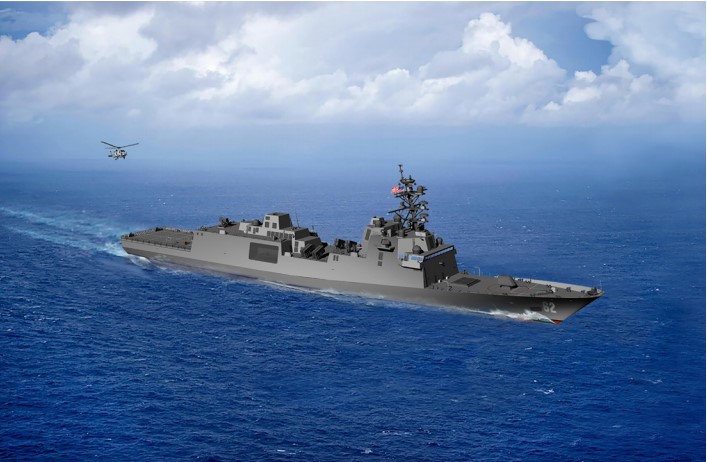An HII Ingalls Shipbuilding [HII] official this week confirmed the company is still interested in potentially being a second shipbuilder for the new Constellation-class frigate program as well the Landing Ship Medium (LSM) program, formerly called the Light Amphibious Warship (LAW).
“The facility itself has excess capacity right now. We put over a billion dollars in the shipyard of the future initiatives that we did and we just completed last year. So the facility within the shipyard has the capacity to handle it,” George Nungesser, vice president for program management at Ingalls Shipbuilding, told reporters Tuesday on the sidelines of the Modern Day Marine conference.

When asked if HII Ingalls is still interested in being the second shipyard for the frigate once the Navy decides to add that option, Nungesser said they are looking at all opportunities and highlighted the company’s experience with surface combatants like the Arleigh Burke-class guided-missile destroyer.
“We are interested in the second frigate. It’s a surface combatant, we know surface combatants. You know…have four generations of surface combatants in our legacy. And we’re very proud of our legacy and to continue that legacy on and we definitely have the workforce to bring forth a good effort as being the second ship builder for the frigate program.”
This reiterates the interest company leadership indicated in January, when Executive Vice President of HII and President of Ingalls Shipbuilding Kari Wilkinson said being the second frigate shipyard “is of great interest to us…we’re very interested in that program,” (Defense Daily, Jan. 13).
HII Ingalls lost out to Fincantieri Marinette Marine to build the first 10 frigates, which started building the first one in August. At the time, Rear Adm. Casey Moton, Program Executive Officer for Unmanned and Small Combatants, said there is no specific timeline for when the Navy might decide to add a second frigate shipyard.
The Navy’s contract with Fincantieri includes the option to order a Technical Data Package before ending production on the 10th vessel, which will allow it to share the information needed to assign another manufacturer to build the ships.
In April, Chief of Naval Operations Adm. Mike Gilday told the Senate Armed Services Committee it was “very important” to ultimately add a second frigate shipyard to enable producing two to three vessels per year total (Defense Daily, April 19).
Nungesser was more vague when asked if they are interested in the LSM, beyond underscoring they have the ability to add more work to the shipyard and monitor future shipbuilding programs.
“At Ingalls we’re always interested in future ship classes, future endeavors. With a legacy of over 85 years, we’re pretty agile to looking at what’s out there in the future. And, you know, we’ll continue to monitor the program development of that particular program and look forward to working with the Navy to see where this goes as soon as something comes out as far as an RFP, things of that nature. But we will always continue to monitor future opportunities.”
Nungesser also underscored that while the shipyard has “abundant capacity to bring on more” shipbuilding across the industry, the bigger issue is “it’s more about retaining and hiring the workforce – and all of industry’s looking at that right now.”
The Marine Corps is planning the LSM around the Marine Littoral Regiments (MLR), with three vessels needed per MLR for 27 total. The service aims to ultimately procure 35 LSM-type vessels to cover maintenance schedules.

The LSM is planned to be 200 to 400 feet long, able to transport up to 75 Marines and 10,000 square feet of cargo over 3,500 nautical miles.
The Marine Corps has contracted with Hornbeck Offshore Services [HOS] to lease modified Offshore Support Vessels as Stern Landing Vessels (SLVs) in a bridging plan to test the LSM concepts. The service will also test the LSM concept with Expeditionary Transfer Dock ships (ESB), Expeditionary Fast Transport ships (T-EPF) and Landing Craft Utility (LCU) vessels.
In March, the Marine Corps Warfighting Lab said it planned to start four stages of experimentation prototyping the SLVs and other LSM-type vessels this year (Defense Daily, March 6).
Last month, the Navy issued a Request For Information looking for industrial sources interested in the detail design and construction of LSM. The notice said the Navy was interested in ultimately procuring four LSMs per year, preferably with a parent design to start from (Defense Daily, May 23).
